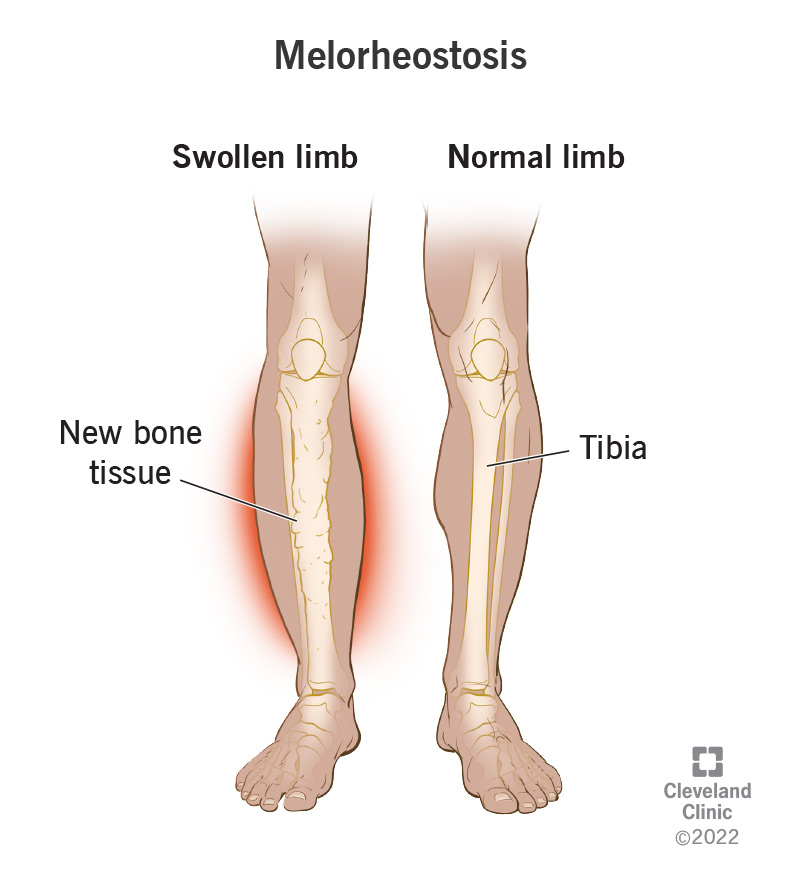Melorheostosis is a rare condition that affects your bones. It causes new bone tissue to grow on top of healthy bones. This leads to irregularly thick or wide bones. You may have pain, limited range of motion or skin changes. There’s no cure for melorheostosis, but treatment can help you live a higher quality of life.
Advertisement
Cleveland Clinic is a non-profit academic medical center. Advertising on our site helps support our mission. We do not endorse non-Cleveland Clinic products or services. Policy

Melorheostosis (meh-lo-ree-ohs-TOE-sis) is a rare bone disorder. It causes new bone tissue to grow on your existing outer bone layers (cortical bones). This tissue growth leads to an overly thick or wide bone. It usually affects only one of your arms or legs, but it can happen in other bones. Symptoms typically appear during childhood or adolescence.
Advertisement
Cleveland Clinic is a non-profit academic medical center. Advertising on our site helps support our mission. We do not endorse non-Cleveland Clinic products or services. Policy
When this new bone tissue grows, it has a characteristic look on an X-ray: Doctors describe it as looking like dripping or flowing candle wax.
Melorheostosis is a very rare type of skeletal dysplasia. Another name for melorheostosis is Leri disease.
Melorheostosis comes from three Greek words:
If you or your child has melorheostosis, unusually thick or wide bones may limit movement. People with melorheostosis may also have a joint deformity (contracture) or pain. As bone tissue grows, you may also notice skin changes, including skin thickening or shininess.
Melorheostosis doesn’t spread to other bones, but it can worsen over time.
Melorheostosis is very rare. Experts estimate that it affects about 1 in 1 million people worldwide.
In about 1 in 2 cases, melorheostosis occurs because of a change (mutation) in the MAP2K1 gene. The MAP2K1 gene makes a specific protein that controls how bone cells grow. This gene change happens randomly (sporadically). It isn’t passed down from your parents.
About half of people with melorheostosis don’t have a MAP2K1 gene mutation. In these cases, healthcare providers don’t know what causes the condition.
Advertisement
About 1 in 2 people with melorheostosis experience symptoms by age 20. Usually, symptoms develop in childhood, possibly even in the first few days of life. They may get more severe over time.
Symptoms usually only affect the arm or leg. Less commonly, you or your child might have symptoms that affect the pelvis, breastbone (sternum) or ribs, such as:
Healthcare providers use imaging tests to diagnose melorheostosis, including:
Healthcare providers may also recommend genetic testing. Genetic tests are blood tests to look for the gene mutation that causes melorheostosis.
There’s no cure for melorheostosis, but treatment can help you or your child manage symptoms. Providers may prescribe treatments to manage pain and improve function, such as:
Melorheostosis isn’t cancerous, and it doesn’t affect your life expectancy. But it can limit your function and movements. You may deal with joint pain or swelling. The right treatment plan can help people with melorheostosis live a higher quality of life.
Because melorheostosis happens randomly, there’s no way to prevent it.
If you or your child has symptoms or received a diagnosis of melorheostosis, ask your healthcare provider:
Several conditions cause symptoms similar to melorheostosis. Your healthcare provider may rule out these conditions during diagnosis, including:
Melorheostosis is a rare bone disorder. It causes new bone tissue to grow on top of existing bone tissue. It usually affects only one limb. It doesn’t spread from bone to bone, but it can worsen over time. If you have melorheostosis, your treatment plan may include medication, physical therapy, occupational therapy or surgery. These treatments can help you live a higher quality of life with melorheostosis.
Advertisement
Last reviewed on 06/07/2022.
Learn more about the Health Library and our editorial process.